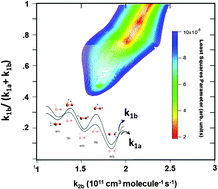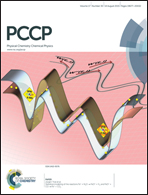Spin-inversion and spin-selection in the reactions FeO+ + H2 and Fe+ + N2O
Abstract
The reactions of FeO+ with H2 and of Fe+ with N2O were studied with respect to the production and reactivity of electronically excited 4Fe+ cations. The reaction of electronic ground state 6FeO+ with H2 was found to predominantly produce electronically excited 4Fe+ as opposed to electronic ground state 6Fe+ corresponding to a spin-allowed reaction. 4Fe+ was observed to react with N2O with a rate constant of 2.3 (+0.3/−0.8) × 10−11 cm3 molecule−1 s−1, smaller than the ground state 6Fe+ rate constant of 3.2 (±0.5) × 10−11 cm3 molecule−1 s−1 (at room temperature). While the overall reaction of 6FeO+ with H2 within the Two-State-Reactivity concept is governed by efficient sextet–quartet spin-inversion in the initial reaction complex, the observation of predominant 4Fe+ production in the reaction is attributed to a much less efficient quartet–sextet back-inversion in the final reaction complex. Average spin-inversion probabilities are estimated by statistical modeling of spin-inversion processes and related to the properties of spin–orbit coupling along the reaction coordinate. The reaction of FeO+ with H2 served as a source for 4Fe+, subsequently reacting with N2O. The measured rate constant has allowed for a more detailed understanding of the ground state 6Fe+ reaction with N2O, leading to a significantly improved statistical modeling of the previously measured temperature dependence of the reaction. In particular, evidence for the participation of electronically excited states of the reaction complex was found. Deexcitation of 4Fe+ by He was found to be slow, with a rate constant <3 × 10−14 cm3 molecule−1 s−1.


 Please wait while we load your content...
Please wait while we load your content...